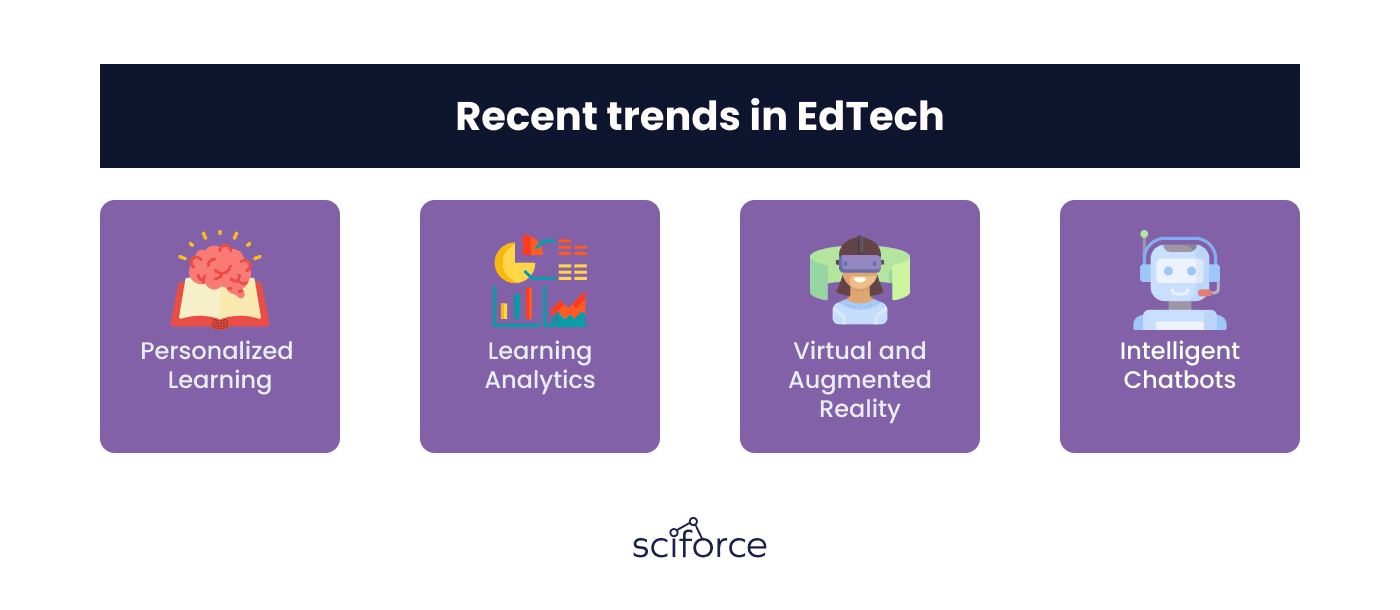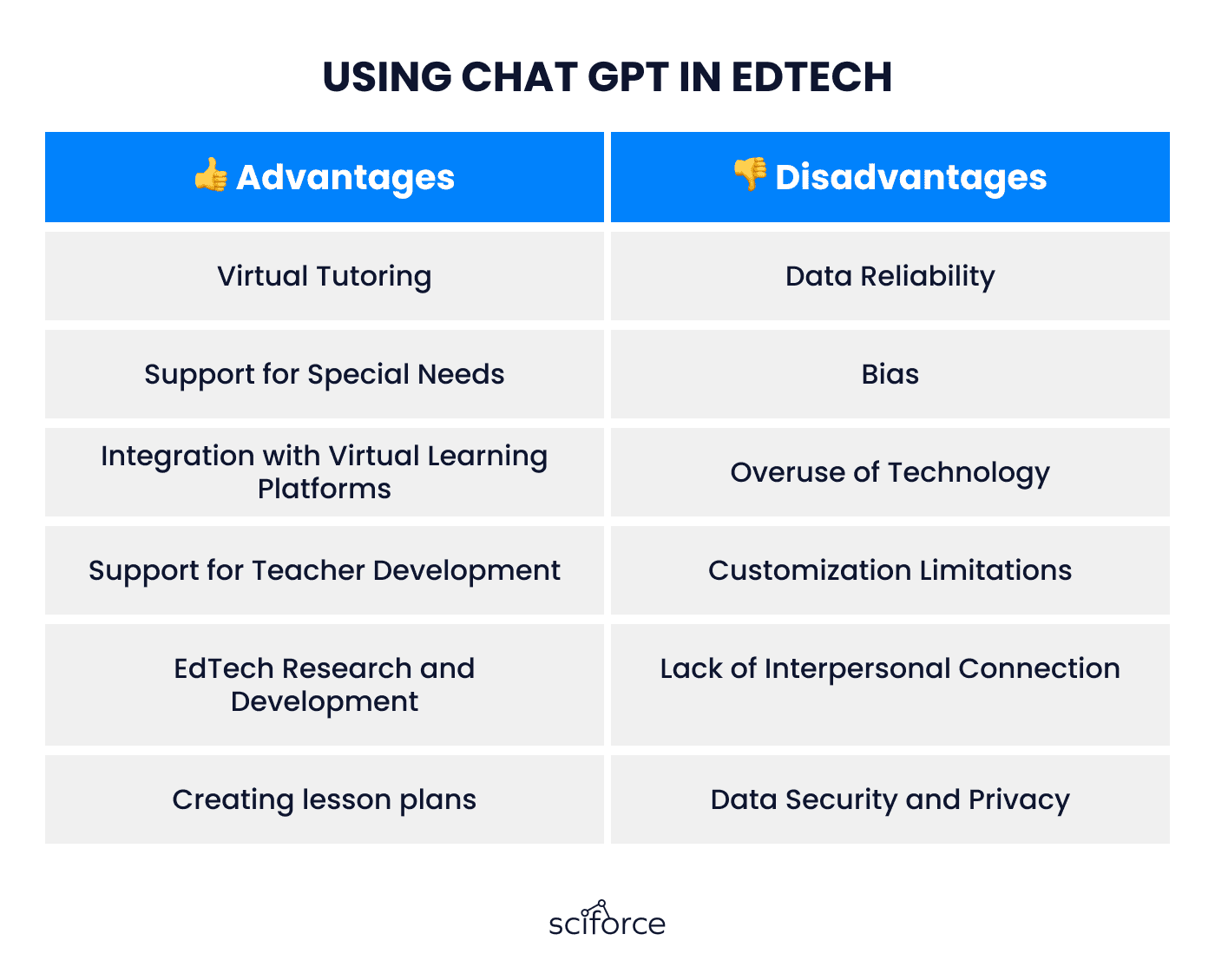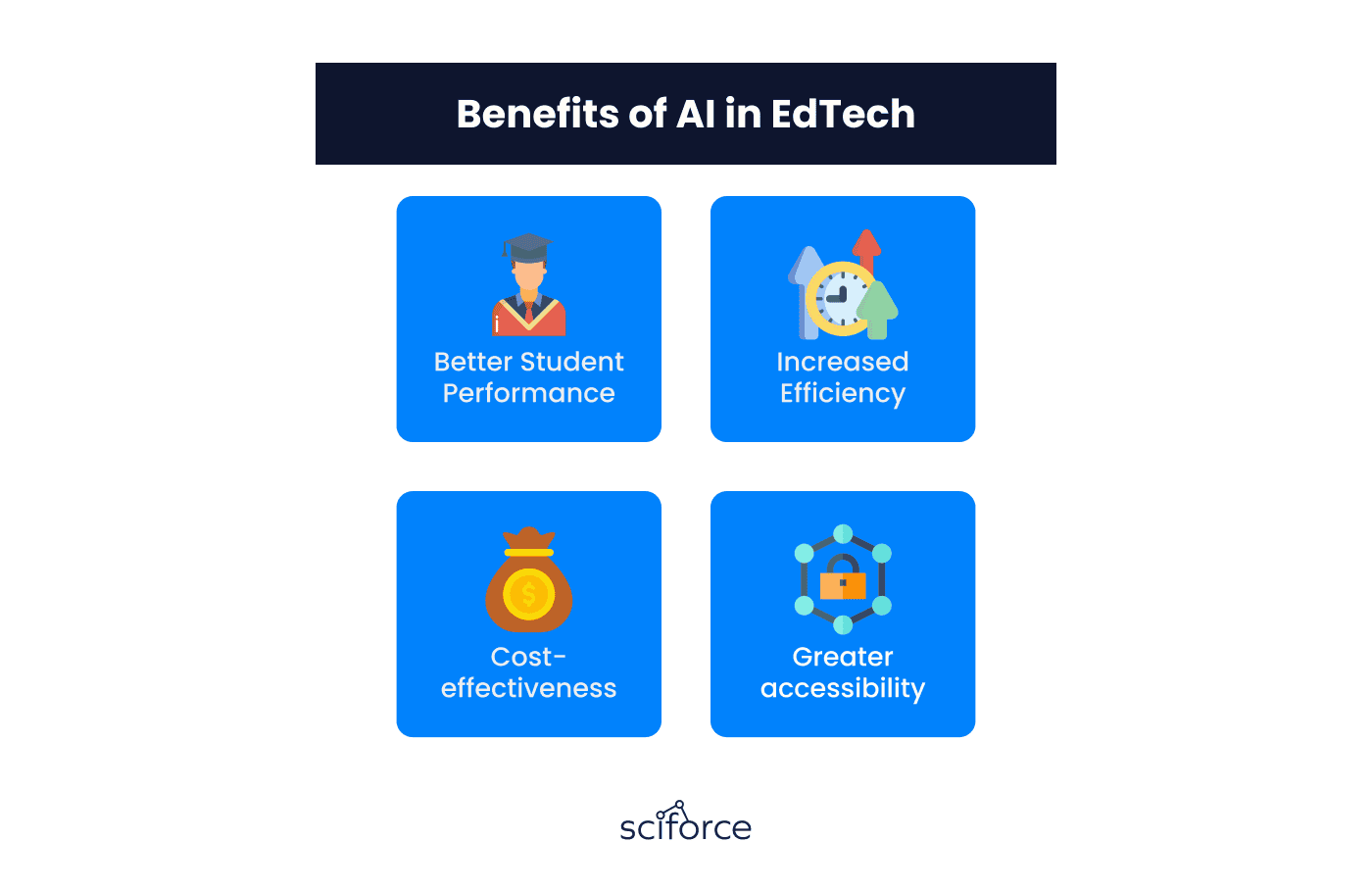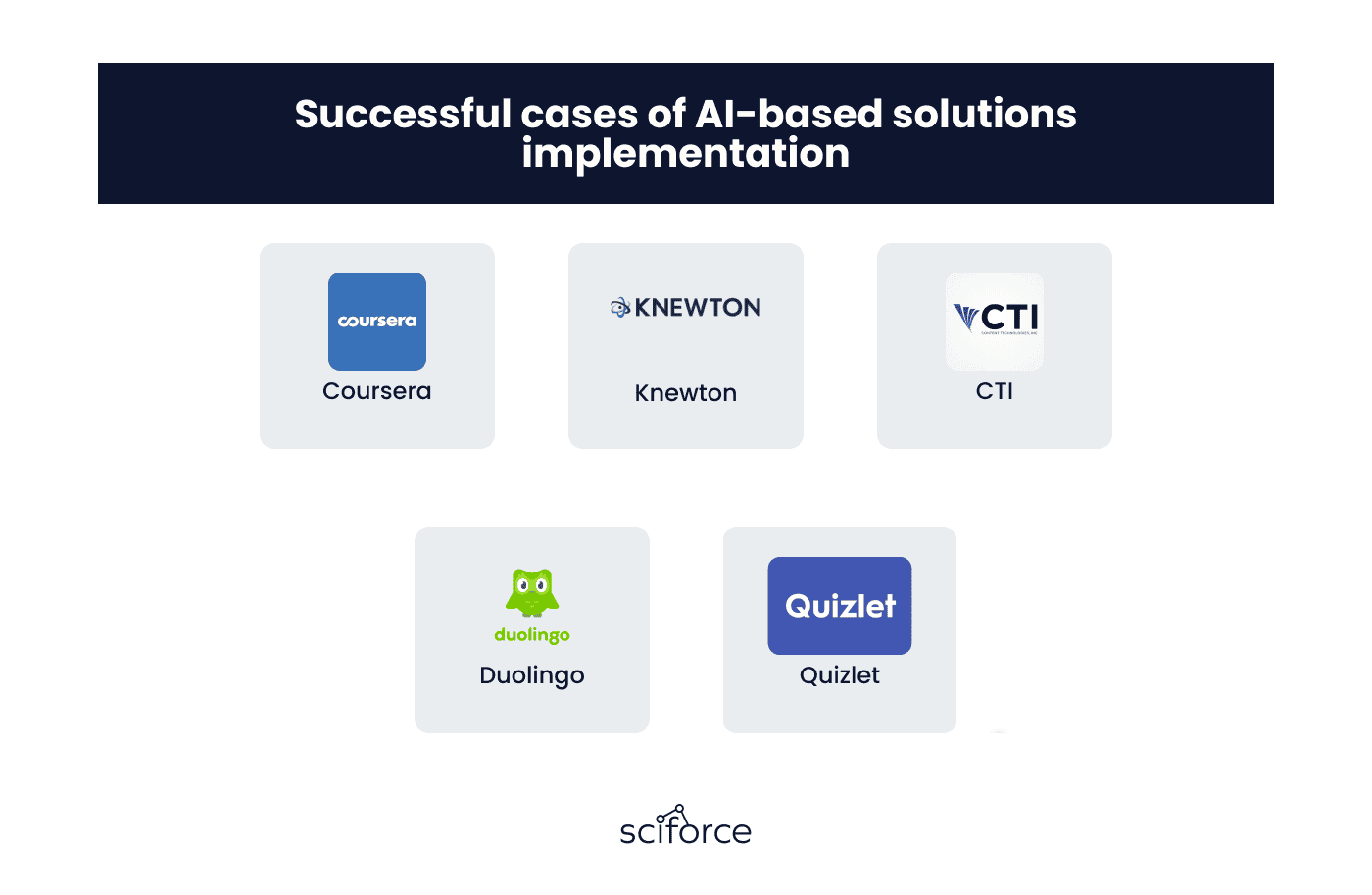The usage of Artificial Intelligence in the world of Education Technologies is totally changing the learning approach, offering truly innovative solutions that transform the experience of students and teachers. AI-based solutions are bringing the education industry to a new level by enhancing the learning experience, making it more personalized, interactive, and efficient. Through the last few years, AI has started gaining popularity in many fields, and the EdTech industry is not an exception: according to the report of Global Market Insights, AI in Education Market size reached USD 4 billion in 2022 and is projected to expand at over 10% CAGR from 2023 to 2032, owing to the growing inclination towards personalized learning.
In this article, we analyze the most important trends of the EdTech industry in 2023, discuss the main advantages and disadvantages of AI in EdTech, the impact of Chat GPT on education, and successful cases of how top companies use AI on their platforms.
Before we discuss specific cases, pros, and cons of AI in EdTech, let's first explore some trends in this field to be able to adjust to customer needs and requirements and outstand in the highly competitive market.

One of the most revolutionary trends in educational technology is AI in personalized learning. There are many great general options for obtaining new skills or knowledge on the internet. However, they often do not comply with the expectations and needs of customers in terms of personalization. Here comes AI to solve this problem: AI can tailor educational content and experiences to suit the unique abilities and learning styles of individual students. This is a big shift from traditional teaching methods that often overlook individual learners' needs and capabilities, making education more enjoyable and accessible.
This revolution has been made possible through the use of adaptive learning algorithms and intelligent tutoring systems. Basically, adaptive learning algorithms can adjust the difficulty, pace, and type of content based on the learner's individual performance. These systems take into account the strengths, weaknesses, and even the interest areas of a student to provide a learning pathway that keeps a person engaged and contributes to academic growth.
Intelligent tutoring systems serve as personal tutors to students, providing personalized support and feedback. These systems use AI to spot a point where a student might be struggling and to provide detailed guidance on those specific areas. The main advantage of those systems is in their ability to deliver feedback in real-time.
Personalized learning with AI is already showing promising results. Studies have shown that adaptive learning technology can increase student engagement and improve retention rates. Moreover, it allows students to learn at their own pace, reducing stress and making learning a more enjoyable experience. With AI becoming increasingly sophisticated, the potential for truly personalized learning experiences is growing exponentially, promising a future where every learner can access a tailored education that fully unlocks their potential.
Here you can see a few free examples to experience personalized learning: EdApp, Schoox, WalkMe, Raven360, ExplainEverything.
In simple words, learning analytics is the process of collection, processing, and analysis of data about students and their success. This process is performed to optimize learning and the environments in which it occurs. Learning analytics uses AI algorithms to understand how students are learning, what they are struggling with, and how their learning path can be made easier.
This tool helps educators understand which teaching methods and content types are most effective for them. Artificial Intelligence can even predict students' future performance based on their current learning patterns and provide recommendations on how to enhance their experience.
For instance, if a student consistently struggles with problems in Physics classes, AI can identify the pattern and suggest additional, customized practice in this area. On the other hand, if an entire class is struggling with a specific concept, this could indicate an issue with the methods of teaching.
Learning analytics has tight bounds with personalized learning: AI enables the creation of personalized learning paths by providing insights into the learning patterns of each student.
Virtual and augmented reality (VR and AR) technologies create interactive learning environments that significantly enhance the educational experience, especially for kids, as their attention often drops in seconds. VR and AR allow for dynamic and interesting interactions, making education more engaging and, thus, more effective.
Augmented and virtual reality can transport students to any location: forest, ocean, countryside, or any other place just from their classroom or home. These technologies can provide simulations that make difficult and abstract concepts more accessible and easy to understand. For instance, students can explore the structure of a DNA molecule or learn history by walking through different places.
A great example of those technologies was the Google Expeditions program, which allowed students to explore plants' and animals' anatomy, and hundreds of destinations, including museums, monuments, and even underwater exploration.
It is worth mentioning that AR applications can bring interactive content into the real world, thus, making learning more engaging and interesting and allowing students to understand and memorize the information better.
The use of AI in VR and AR in education is still in the early stages, but the potential of those technologies to transform the education industry is enormous.
With the success of Chat-GPT and other AI-based chatbots, using intelligent chatbots has become a growing trend in the Education Technology field. AI-driven chatbots are great virtual assistants that can respond to students' questions instantly, providing 24/7 assistance, facilitating the learning process, and even helping manage administrative tasks such as scheduling and reminders.
AI-based chatbots can perform a wide range of functions: from answering questions and providing explanations of complex concepts to offering personalized study tips and reminders.
For example, a student can ask the chatbot to explain a particular rule, formula, or the meaning of a term. The chatbot, using its NLP capabilities, can understand the question, search its knowledge database, and provide a clear and helpful response.
Furthermore, as we mentioned before, AI chatbots can offer 24/7 instant support and fill the gap when human teachers are unavailable. Chatbots are capable of providing instant feedback on assignments, recommending different resources for study, etc. Also AI-chatbots can also provide a platform to help students who hesitate to ask questions in a regular class.
The usage of NLP as a subfield of AI in intelligent chatbots is set to redefine the landscape of learner support in education. By providing responsive, personalized, and accessible support, AI chatbots are reshaping how we engage with and facilitate learning, opening exciting new possibilities for Education Technology.
Well, using Chat GPT in the education industry has its own pros and cons.

Let’s start with the main advantages:
Virtual Tutoring: ChatGPT can serve as a virtual tutor, assisting students with homework, assignments, and exam preparation. It can provide real-time explanations, problem-solving techniques, and feedback.
Support for Special Needs: It can help students with special needs by providing conversational interfaces, text-to-speech and speech-to-text functionality, note-taking assistance, and customized accommodations.
Integration with Virtual Learning Platforms: ChatGPT can enhance the functionality of online classrooms, offering on-demand support, engaging dialogues, and facilitating collaborative learning experiences.
Support for Teacher Development: It can facilitate collaborative learning groups, provide advice on teaching practices, and give access to relevant research publications, thereby improving instructional methods and encouraging ongoing development.
EdTech Research and Development: ChatGPT can support research and development initiatives in educational technology, helping to analyze patterns, educational data, and produce new knowledge.
Creating lesson plans: Edtech companies can use ChatGPT to automate the processes of content production and curation, creating lesson plans, interactive learning materials, and curating educational resources.
Disadvantages of using Chat GPT in EdTech:
Data Reliability: Responses from ChatGPT are based on patterns seen in its training data, which may contain errors, biases, or out-of-date knowledge. This could lead to inaccurate or misleading responses.
Bias: Inadvertent biases in ChatGPT’s training data may be visible, potentially reinforcing inequalities and prejudices in the classroom.
Overuse of Technology: Overuse of AI technologies like ChatGPT might deter kids from acquiring critical thinking, problem-solving, and creative skills.
Customization Limitations: ChatGPT might not fully account for each student’s particular learning requirements, lacking the flexibility to accommodate different learning preferences, styles, and skills.
Lack of Interpersonal Connection: The advantages of interpersonal connection in education cannot be replaced by ChatGPT. Overreliance on it may hamper the growth of interpersonal abilities and cooperative learning experiences.
Data Security and Privacy: The processing of user interactions by ChatGPT raises concerns over data security, privacy or even intellectual prorety aspects.
Chat GPT can be helpful for the EdTech industry, though, tutors need to take into account both: the pros and cons of this technology before implementing it in the education process.
The integration of artificial intelligence in the educational sector shows many potential benefits for both educational institutions and learners:

Better Student Performance: The tools powered by AI can assist students in explaining complex concepts, thus, enhancing academic achievements and increasing graduation rates.
Increased Efficiency: Automation of grading assignments and other administrative tasks saves up a lot of valuable time for teachers. This enables tutors to concentrate on teaching more and offer personalized support to students who may need it.
Cost-effectiveness: AI-driven solutions can be more cost-effective than traditional educational approaches, especially in scenarios of remote or distance learning where physical resources might be limited and not that accessible.
Greater accessibility: AI-based solutions can offer broader access to education for students who study remotely, enabling them to learn from the best lecturers and use educational resources from anywhere in the world.
Adaptive Learning Platforms: Leading EdTech companies are using AI algorithms to create adaptive learning platforms that tailor and customize content and instructions to individual students' abilities and learning styles.
Intelligent Tutoring Systems (ITS): EdTech companies also use intelligent tutoring systems that allow to simulate the experience of one-on-one tutoring by providing immediate feedback, clarifying doubts, and offering assistance based on each student's needs.
Gamification and Learning Apps: To make studying more enjoyable and students more concentrated, many EdTech companies are integrating educational games into their platforms. By using gamification, we are changing the attitude of students towards studying: from a chore, it becomes an interactive and engaging experience, which can enhance motivation. For example, Duolingo and other companies use AI to create gamified learning experiences.

Coursera: Coursera, one of the most popular online learning platforms in the world, uses AI to provide personalized course recommendations to learners. The system analyzes a user's past behavior, course history, and interactions on the platform to suggest the most relevant courses. Also, the platform uses an AI-powered grading system that identifies common mistakes and provides feedback to help students improve their understanding.
Knewton: Knewton uses AI to provide personalized learning experiences to students by analyzing a student's performance and adjusting course material. Students receive personalized lesson plans, content recommendations, and study strategies. This allows them to learn more effectively at their own pace.
Content Technologies, Inc. (CTI): CTI uses AI to create customizable textbooks that adjust to the needs of individuals. By using machine learning and natural language processing, they can transform any standard textbook into an interactive and adaptive learning resource.
Duolingo: Duolingo, one of the most popular language-learning platforms, uses AI to personalize the process of language learning for its users. Its AI algorithms analyze user's learning patterns and choose the difficulty level of exercises accordingly. Duolingo also uses AI-driven chatbots for interactive language practice.
Quizlet: is a popular online learning platform that uses gamification and AI to enhance student engagement and learning. The AI algorithms analyze student performance to recommend personalized study materials and games, catering to different learning styles and ensuring continuous learning challenges and support.
These use cases show how AI is revolutionizing education and learning experiences today. By using the potential of AI, these platforms have successfully improved engagement, enhanced learning outcomes, and personalized education on a global scale.
To sum up, the integration of AI in the EdTech industry can absolutely revolutionize the way we learn and teach. AI-based solutions prove that they can transform the learning process and make it more personalized, interactive, and efficient. In this article, we explored the biggest trends in AI in EdTech, such as personalized learning, learning analytics, virtual and augmented reality, and intelligent chatbots. By applying those technologies in the educational system, developed products will meet the expectations of the customers and solve their challenges. If you would like to implement AI in your education platform and unlock new opportunities in the industry, do not hesitate to contact us!